The 1936 Cord 810 was first introduced at the 1935 New York Auto Show. The car appeared sleek and fast and was considered cutting edge. So instantly accepted was the Cord 810 that orders for the new model were written up on the spot at the New York Auto Show.
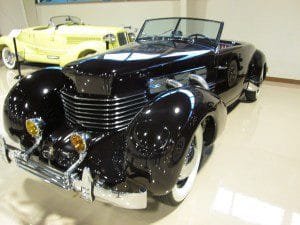
The Museum of Modern Art named the Cord 810, designed by Gordon Miller Buehrig, among the ten most significant of the twentieth century. Many vintage auto enthusiasts consider the front wheel drive sporty Cord 810 the most beautiful car ever built. This car was built low, sleek and modern looking. The car’s long hood was squared at the end which earned it the name “coffin hood” and “coffin nose“.
A good many vintage auto enthusiasts feel that Gordon Miller Buehrig created some of the finest auto designs in the history of the industry.
E.L. Cord / Initial Success and Later Bankruptcy
The Cord automobiles were named after Errett Loban Cord the one time president of Auburn-Cord-Duesenberg. Cord, a very successful automobile salesman and marketer, took over Auburn during the 1920’s at thirty years of age and made significant changes to it’s sales and distribution network that did boost the company’s sluggish sales. Cord was known to be an excellent promoter.
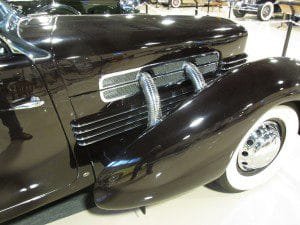
The end of Auburn-Cord-Duesenberg came in 1937 during the Great Depression. Cord was caught up in a stock scandal and the company was losing money due to the tough economy. The profit margins on their vehicles were not nearly what they should have been. By 1935 and 1936 the company was in trouble and E.L. Cord was replaced as president.
After the bankruptcy the assets of the company were purchased by a man named Dallas Winlsow from Detroit Michigan. Owners who were stuck with their Duesenbergs, Auburns and Cords could look to this new Detroit operation for parts and service.
A Design By Gordon Miller Buehrig
As mentioned above, Gordon Buehrig has been credited with some of the finest auto designing ever put on paper. With Cord, Buehrig could depart from the conservative designs of the era and put together a unique cosmetic touch. E.L. Cord put emphasis on cosmetics and revolutionary styling to help sell cars and Buehrig came through splendidly.
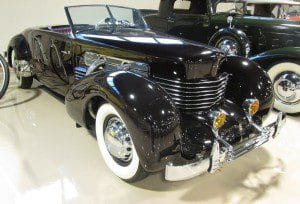
Starting his designing career at Gotfredson Body Company followed by years at Dietrich Incorporated, Packard, GM and Stutz, Gordon Miller Buehrig would become the chief designer of the Cord automobile. Buehrig was also considered the chief designer of the Duesenberg, one of the most popular automobiles of the wealthy and had a close relationship to the Duesenberg brothers. Buehrig would end his auto designing career working for the Budd Company and then the Ford Motor Company until 1965.
The Cord 810 was the car that would try to keep the company out of bankruptcy. As beautiful and cutting edge as these automobiles were and even though the engineering was quite innovative, the Cord 810 could not save the company and Auburn-Cord-Duesenberg filed for bankruptcy and the 810 was only produced for two years.
The Cord brand was produced from 1929 through 1932 and then from 1936 through 1937. The Cord 810 and 812 models during the company’s last two years in business are the most popular of the Cord automobiles.
Four 1936 Cord 810 Models
Four Cord 810 models were offered in 1936. These were the Beverly Sedan, the Westchester Sedan, the Sportsman and the Phaeton. All had the same wheelbase.
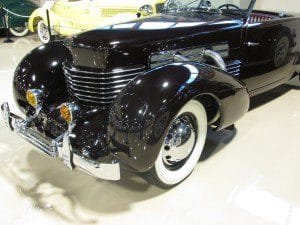
1936 Cord 810 Specifications
The 1936 Cord 810 was produced with a 288 cubic inch Lycoming V-8 engine with aluminum heads. The engine delivered 125 horsepower. The Cord 812 model produced in 1937 had the same engine as the 810 except with the addition of a supercharger. The supercharger in 1937 pushed the horsepower up to 170.
Transmission on the car was a four speed pre-selector manual.
The 1936 Cords had unit construction with an all steel body.
Front suspension was independent with transverse leaf springs. Rear suspension was a tubular steel axle on semi-elliptic leaf springs.
Brakes consisted of four wheel hydraulic drums with cast iron linings.
The 1936 Cord 810’s wheelbase was 125.0 inches. It’s overall length was 195.5 inches and width 71.0 inches. Curb weight came in at about 3,715 lbs.
1936 Cord 810 sales came in at about 1,174 vehicles. In 1937 only about 1,065 of the Cord 812’s were sold.
The new car price tag for the 1936 Cord 810 was around $3,000.
See the AutoMueumOnline articles on the links below…
The 1929 Auburn Boattail Speedster
A Finely Restored 1936 Ford Woody Station Wagon
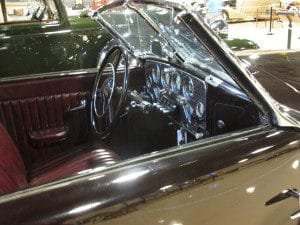
Valuable Collector Cars
All Cord automobiles are very popular collector cars. Not only is the history of the Auburn-Cord-Duesenberg company quite unique but their cars were considered cutting edge at the time and not an enormous number of them built. Perhaps the most popular collector car manufactured by this company was the Duesenberg Model J. The Cord 810 and 812 models have just about equal popularity.
The total production of the 1936 810’s and the 1937 812’s didn’t even reach 2,500. These automobiles are rare and some restored originals have current six figure values.
You may also find Cord 810 replica’s being offered usually in the $25,000 to $35,000 price range.
(Article and photos copyright 2014 AutoMuseumOnline)